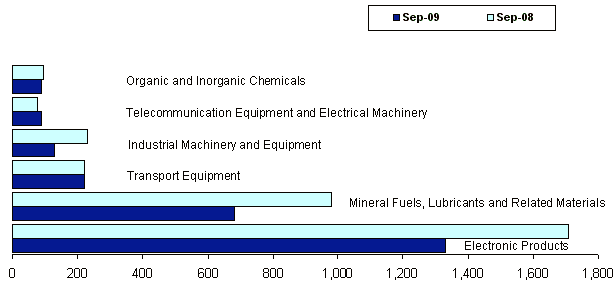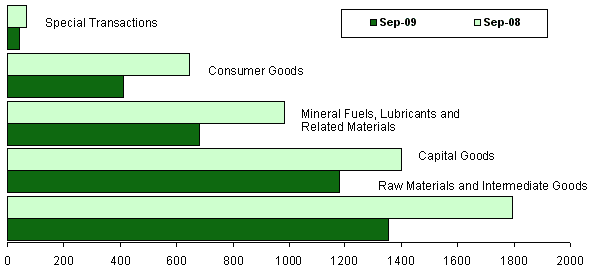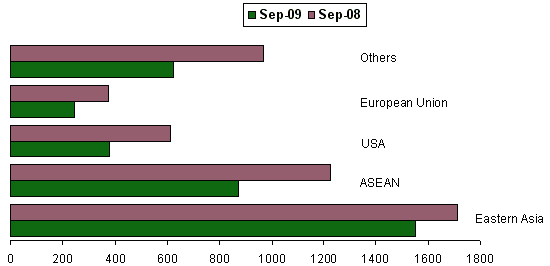| |||||||||||||||||||||||||||||||||||||||
r - revised
Top 10 Philippine Imports from All Countries: September 2009 | |||
Gainers | Losers | ||
Telecommunication Equipment and Electrical Machinery | 17.4 | Cereals and Cereal Preparation | -74.8 |
Medicinal and Pharmaceutical Products | 6.5 | Industrial Machinery and Equipment | -45.0 |
Transport Equipment | 0.1 | Mineral Fuels, Lubricants and Related Materials | -30.6 |
|
| Iron and Steel | -28.8 |
|
| Plastics in Primary and Non-Primary Forms | -23.7 |
|
| Electronic Products | -22.1 |
|
| Organic and Inorganic Chemicals | -8.1 |
JANUARY TO SEPTEMBER 2009 TOTAL TRADE STOOD AT $59.318 BILLION
Total external trade in goods for January to September 2009 reached $59.318 billion, a 29.6 percent drop from $84.283 billion recorded during the same 9-month period in 2008. Total imports posted a 30.2 percent annual decrease from $45.383 billion to $31.677 billion. Total exports likewise plunged by 28.9 percent from $38.900 billion in January to September of 2008 to $27.641 billion. Thus, the balance of trade in goods (BOT-G) for the Philippines registered a deficit of $4.036 billion during the 9-month period in 2009 from $6.483 billion deficit in the same 9-month period last year.
Figure 1A Philippine Trade Performance in January - September : 2009 and 2008
(F.O.B. Value in Million US Dollars)

Figure 1B Philippine Trade Performance in September : 2009 and 2008
(F.O.B. Value in Million US Dollars)

SEPTEMBER 2009 IMPORTS DROPPED BY 25.0 PERCENT
Combined import and export merchandise trade for September 2009 declined by 21.8 percent from $9.337 billion in September 2008 to $7.306 billion. This was due to the decrease in total merchandise imports by 25.0 percent from $4.891 billion in September 2008 to $3.670 billion. Similarly, total exports declined by 18.2 percent from $4.446 billion to $3.636 billion. The balance of trade in goods (BOT-G) in September 2009 recorded a deficit of $34 million, lower than the last years recorded deficit of $445 million. Month-on-month, total imports for September 2009 inched up by 1.5 percent from $3.617 billion recorded in August 2009.
ELECTRONIC PRODUCTS ACCOUNTED FOR 36.3 PERCENT OF IMPORT BILL
Accounting for 36.3 percent of the aggregate import bill and the countrys major commodity imported in September 2009, payments for Electronic Products (including consigned and direct importation using the expanded coverage of electronic products) in September 2009 amounted to $1.331 billion. It went down to 22.1 percent over last year's figure of $1.708 billion. This was due to the 25.1 percent decrease inComponents/Devices (Semiconductors) which comprised the biggest share of 26.7 percent among the major groups of electronic products. However, electronic products showed an increase of 2.2 percent month-on-month from $1.302 billion in August 2009.
Imports of Mineral Fuels, Lubricants and Related Materials comprising 18.6 percent of the total imports in September 2009 ranked second. Import payments decelerated by 30.6 percent from previous years level of $981.55 million to $681.73 million.
Transport Equipment, amounting to $221.36 million was the Philippines third top import for the month with 6.0 percent share to total imports and showed a positive annual growth of 0.1 percent.
Contributing 3.5 percent to the total import bill and the countrys fourth top imports in September 2009 was Industrial Machinery and Equipment with payments placed at $127.27 million. The amount decelerated by 45.0 percent from last years recorded value of $231.30 million.
Fifth in rank and with 2.4 percent share, Telecommunication Equipment and Electrical Machinery (including telecommunications and sound recording and reproducing apparatus and equipment)registered $89.53 million worth of imports, higher by 17.4 percent from its year ago level of $76.29 million.
Organic and Inorganic Chemicals exhibiting 2.4 percent of the total imports ranked sixth, valued at $88.17 million and showed a decrease of 8.1 percent from its year ago level of $95.93 million.
Rounding up the list of the top ten imports for September 2009 were Iron and Steel, accounting for $80.58 million decreased by 28.8 percent; Cereals and Cereal Preparations amounting to $69.70 million went down by 74.8 percent, the biggest annual growth drop among the top ten imports; Plastics in Primary and Non-Primary Forms valued at $68.85 million fell by 23.7 percent; and Medicinal and Pharmaceutical Products worth $61.46 million increased by 6.5 percent.
Aggregate payment for the countrys top ten imports for September 2009 reached $2.819 billion or 76.8 percent of the total import bill.
Figure 2 Philippine Top Six Imports in September : 2009 and 2008
(F.O.B. Value in Million US Dollars)

RAW MATERIALS AND INTERMEDIATE GOODS ACCOUNTED FOR 36.9 PERCENT OF THE TOTAL IMPORTS
Accounting for 36.9 percent of the total imports, payments in September 2009 for Raw Materials and Intermediate Goods amounted to $1.356 billion or 24.5 percent decline over last year's figure of $1.796 billion. Compared to the previous months level, purchases went down by 1.4 percent from $1.375 billion. Semi-Processed Raw Materials having the biggest share of 33.5 percent and valued at $1.231 billion decreased by 23.8 percent year-on-year from $1.615 billion. contract.
Capital Goods, contributing 32.2 percent to the total imports, plummeted by 15.7 percent from $1.399 billion in September 2008 to $1.180 billion. Similarly, Mineral Fuels, Lubricants and Related Materialswith 18.6 percent share, plunged by 30.6 percent from its year ago level of $981.55 million to $681.73 million.
Purchases of Consumer Goods amounted to $410.74 million or a negative growth of 36.3 percent from $645.17 million in September 2008, while Special Transactions dropped by 39.7 percent from $68.97 million in September 2008 to $41.56 million.
Figure 3 Philippine Imports by Major Type of Goods in September : 2009 and 2008
(F.O.B. Value in Million US Dollars)

JAPAN ACCOUNTED FOR 14.6 PERCENT OF IMPORT BILL
Japan (including Okinawa), the country’s biggest source of imports for September 2009 with 14.6 percent share, recorded payments worth $534.15 million contracted by 5.8 percent from $566.74 million in September 2008. Revenue from the country’s exports to Japan, on the other hand, reached $610.40 million, generating a total trade value of $1.145 billion and $76.25 million trade surplus for the Philippines.
United States of America (USA) which includes Alaska and Hawaii with 10.4 percent share of the total import bill amounting to $379.75 million followed as the second biggest source of imports for September 2009. This value is lower by 37.9 percent from $611.66 million recorded in September 2008. Exports toUSA amounted to $648.33 million, yielding a two-way trade value of $1.028 billion and a trade surplus of $268.59 million.
Peoples Republic of China came third, accounting for 9.3 percent share of the total import bill in September 2009 decreased by 9.9 percent from $377.13 million in September 2008 to $339.83 million in September 2009. Exports to Peoples Republic of China amounted to $169.08 million resulting to a total trade value of $508.91 million and a trade deficit of $170.75 million.
Rank fourth in September 2009 and with 8.6 percent share was Singapore valued at $314.15 million. This amount diminished by 35.4 percent from $486.35 million posted in September 2008. Exports toSingapore amounted to $221.71 million resulting to a total trade value of $535.86 million and a trade deficit of $92.44 million.
Fifth in rank is Republic of Korea, representing 8.3 percent of the total import bill in September 2009, amounting to $306.25 million. Export receipts from Republic of Korea in September 2009 reached $160.67 million yielding a total trade value of $466.93 million and a trade deficit of $145.58 million.
Other major sources of imports for the month of September 2009 were Taiwan, $253.80 million; Thailand, $235.58 million; Saudi Arabia, $149.47 million; Malaysia, $139.40 million; and Indonesia, $136.21 million.
Payments for imports from the top ten sources for September 2009 amounted to $2.789 billion or 76.0 percent of the total import.
Figure 4 Philippine Imports by Country in September : 2009

IMPORTS FROM EASTERN ASIA WORTH $1.553 BILLION
Philippines total imports in September 2009 with Eastern Asia (China, Hong Kong, Japan, Macau, Mongolia, North Korea, South Korea and Taiwan) represented 42.3 percent of the county’s total imports with total payments of $1.553 billion or a negative growth of 9.3 percent from September 2008 level of $1.711 billion. Total exports to member-countries of Eastern Asia was valued at $1.517 billion, resulting to a total trade of $3.070 billion and a balance of trade in goods (BOT-G) deficit of $36.42 million.
Imports from ASEAN member-countries in September 2009 accounted for 23.7 percent share, a decrease of 29.0 percent from $1.227 billion registered in September 2008 to $871.34 million. Exports to ASEANmember-countries worth $523.95 million resulted to a total trade of $1.395 billion and trade deficit of $347.39 million.
September 2009 imports from European Union were valued at $244.38 million while exports to member-countries of European Union were worth $762.92 million. This aggregated to total trade of $1.007 billion and a trade surplus of $518.54 million.
Figure 5 Philippine Imports by Selected Economic Bloc in September : 2009
(F.O.B. Value in Million US Dollars)

Technical Notes:
1. Adjustments on electronic import statistics are based on the transactions that pass through the Automated Cargo Operating System (ACOS) of the Bureau of Customs (BOC).
2. Starting with the January 2007 Press Release, analysis and tables are based on the 2004 Philippine Standard Commodity Classification (PSCC) groupings. This is in compliance with NSCB Resolution No. 03, Series of 2005 entitled Approving and Adopting the 2004 Philippine Standard Commodity Classification by all concerned government agencies and instrumentalities.
(Sgd.) CARMELITA N. ERICTA |
Source: Foreign Trade Statistics Section
Industry and Trade Statistics Department
National Statistics Office
Manila, Philippines
e-he K5:orxan style='font-size:10.0pt;font-family:"Arial","sans-serif"; mso-fareast-font-family:"Times New Roman";color:black'>2. Starting with the January 2007 Press Release, analysis and tables are based on the 2004 Philippine Standard Commodity Classification (PSCC) groupings. This is in compliance with NSCB Resolution No. 03, Series of 2005 entitled "Approving and Adopting the 2004 Philippine Standard Commodity Classification" by all concerned government agencies and instrumentalities.
(Sgd.) CARMELITA N. ERICTA |
Source: Foreign Trade Statistics Section
Industry and Trade Statistics Department
National Statistics Office
Manila, Philippines
